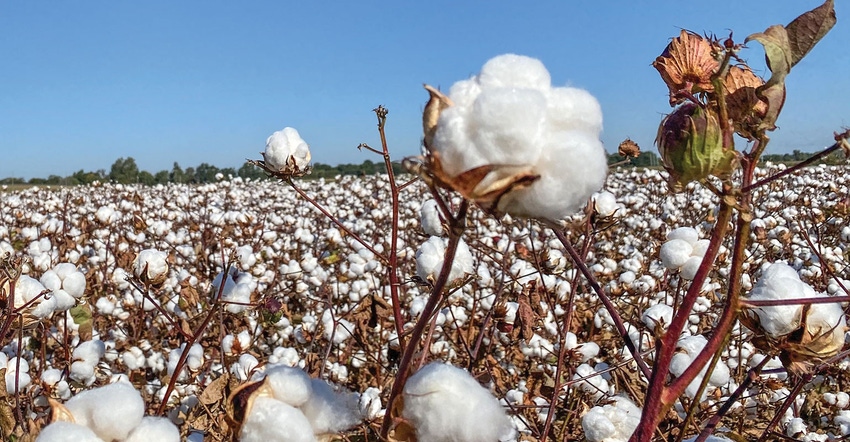
The University of Arkansas hosted its first-ever virtual Cotton Field Day on Oct. 1. The event was moderated by Bill Robertson, Extension cotton agronomist, and featured presentations on soil health, weed control and insect management. Robertson also shared a 2020 cotton season overview. The event was capped off with a live question-and-answer session.
Cotton acres in Arkansas are down considerably from last year, mainly due to dismal spring planting conditions and commodity prices, according to Robertson.
While yield potential looked good over much of the summer, late August and September rains contributed to boll rot and hard lock, particularly in early-planted cotton. The cool, wet finish to the season could negatively impact yields.
“We were looking at a state record for yield,” said Robertson, “but Hurricane Laura and the rain that came behind it laid a lot of that early cotton over. That took us from a great crop to a good crop. Although, I am hearing some reports of 1,300 to 1,400 pounds.”
When discussing what could be in store for 2021, Robertson said he expects to see a major shift from the second-generation Bt technologies, such as Bollgard 2, WideStrike and TwinLink, to three-gene trait Bt technologies, Bollgard 3, WideStrike 3 and TwinLink Plus. About 30% of Arkansas cotton acres are currently planted to three-gene Bt varieties.
“We are starting to see worm control issues in our two-gene varieties and the three-gene varieties will enhance worm control,” Robertson said. “To date, the major limitation to this shift has been the lack of high-yielding three-gene varieties, but we expect to see commercial availability of several high-yielding three-gene varieties available for planting next year.”
Some of those varieties are currently being evaluated in Arkansas’ performance tests. Robertson said the results of those tests would be available in December at the university’s variety testing program website.
Time for residuals on ryegrass
Resistant weed management questions dominated the post-field day Q&A. Concerns over possible dicamba-resistant pigweed were brought up.
“We do not currently have dicamba-resistant pigweed in Arkansas,” said Tom Barber, Extension weed specialist, “although we are looking at populations in northeast Arkansas where we know we’re losing sensitivity to herbicides.”
Resistant ryegrass has been steadily marching north across the state for much of the past decade. Producers posed questions to Barber on how to best manage it. His advice: act quickly.
“Don’t wait until spring to take action if you have resistant ryegrass in your fields,” Barber said. “Put out a Group 15 residual herbicide in mid- to late-October before it emerges. If it has already emerged, mix in gramoxone. If we don’t take care of ryegrass in the fall, the root mass becomes very large and hard to kill with spring burndown.”
Cover crops for weed control
Field day attendees also posed questions on the best cover crop varieties for weed suppression. For cotton, the specialists recommended a grass crop, like cereal rye.
“For growers that are new to cover crops, cereal rye is the cover crop with training wheels,” Robertson said. “It’s easy to get established and easy to terminate. It’s a good one to cut your teeth on.”
“I always tell growers to select a cover crop based on the desired benefits,” said Matt Fryer, Extension soil health instructor. “We want to precede cotton with a grass crop, but for growers looking to improve soil health and water infiltration, consider adding black oats to the cereal rye to diversify the mix.”
Fryer said if planted too late in the season, it is difficult to see benefits from brassicas, like tillage radishes or turnips. Growers planting cover crops in fields with resistant ryegrass, are encouraged to get the crop established early before ryegrass emerges. Fryer also cautioned growers to never plant annual rye as a cover crop.
See more
The recorded presentations from the field day are available now at aaes.uark.edu/field-days/cotton/. A recording of the live broadcast with the question-and-answer session will also be available on the website at a later date. Viewers will have an opportunity to watch the complete recording of the field day for certified crop advisor continued education units.
About the Author(s)
You May Also Like






